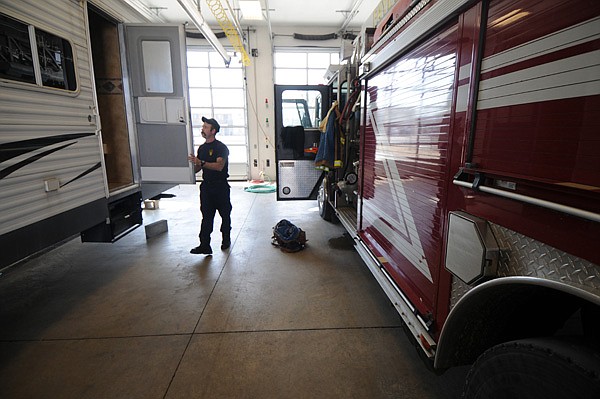FAYETTEVILLE — No one knows who’s at fault for a mold outbreak at the city’s newest fire station, but that doesn’t mean the city won’t be footing part of the bill to fix it.
Fire Chief David Dayringer said the city will open bids Monday for a heating, ventilation and air conditioning system for Station No. 3 at 1050 S. Happy Hollow Road. City officials say mold developed in the current system and forced firefighters to evacuate the station in August.
Tests identified faulty air ducts as the cause of the mold.
The city spent about $4,300 for a limited indoor air quality assessment from the Environmental Enterprise Group. The mold was removed by Complete Restoration, a Springdale company.
Dayringer said the cost of the new system, along with testing and mold abatement, will be split among the city, architect, general contractor and engineer.
“We all have to play a part in the responsibility,” he said. “Everyone is still in agreement to split the cost of fixing it.”
City Attorney Kit Williams said splitting the cost could save the city money in the long run.
“We’re trying to settle it out as fairly as possible,” he said. “Normally, it’s better than going into full-blown litigation to determine who did what and when and how much responsibility they had. If you can solve it like this, it saves litigation time and expense.”
City officials say they don’t know how much it will cost for the new system, but Mayor Lioneld Jordan is satisfied with the funding agreement.
“No one wants to get into large legal issues and exact costs of stuff,” Jordan said. “I’m just glad we could get it all worked out and get the firefighters back in there so they can provide that good level of protection that everyone needs.”
Station No. 3’s fire company, which includes a captain, driver and firefighter on each of three shifts, left the station Aug. 13 after mold was discovered. They worked out of Station No. 1 at 1 E. Center St. They returned to Station No. 3 in December.
“For the first month or so, they worked out of a FEMA trailer owned by the county,” Dayringer said. “It was their quarters while the rest of the station got buttoned up. It fit in the apparatus bay and we ran a sewer line to it. They ran the fire truck out of the other bay.”
Dayringer said air ducts weren’t properly installed when the station was built. He said the mechanical contractor altered plans to move the ducts.
“There were things in the initial drawings that weren’t installed and some things that weren’t connected properly,” he said.
As a result, he said, gaps in the shell of the building began allowing outside air in.
“Mold spores are everywhere,” Dayringer said. “They become a problem when the moisture is high inside a building and you have a humidity higher than 55 to 60 percent. The heating and air conditioning ventilation system in our building wasn’t keeping the humidity below that level so mold started to grow in places we couldn’t see. By August, it got to the point where it was visible to firefighters.”
Station No. 3 was touted as the “greenest,” or most environmentally sustainable, station in Fayetteville. The 6,500-square-foot building features sustainable elements, such as automatic overhead lighting, recycled wood countertops and reprocessed rubber flooring. The two-bay station was designed by Don Spann and built by Heckathorn Construction. The engineer for the project was Charles Batson of Batson Bravo Engineers in Little Rock.
Heckathorn declined to comment on the cost-share agreement. Span was out of his office Friday and wasn’t expected to return until next week. A message left for Batson wasn’t returned.
Dayringer said the mold was traced to the building’s attic and consisted of two types — stachybotrys and aspergillus.
Allergic reactions, such as sneezing, watery eyes, sore throat and stuffy nose, are the most common health problems related to mold.
Dayringer said he didn’t receive any reports of illness attributed to mold.
Paul Becker, finance director, said the Fire Department will use money from its operational budget to pay for its portion of the new system, as well as the testing and mold abatement.
“I think it’s an equitable agreement for everyone,” he said. “In the future, we’ll have to be more cognizant of the risk in any new construction. There are things we can look at more carefully.”
Dayringer said money in the operational budget is typically used for routine maintenance and repair needs.
Though Dayringer won’t know how much the department will have to spend for a week or two, he said it will likely force him to put maintenance needs on hold at other stations.
“We’ve had some normal wear and tear at our stations,” he said. “For instance, we had an air conditioner that went out at Station No. 1 so we had to begin repairing that. There were some structural things that had to be done to the roof supports and that’s the type of thing that the operational budget is for. We’ve put some things on hold, but not that, because the heat was killer last summer.”

